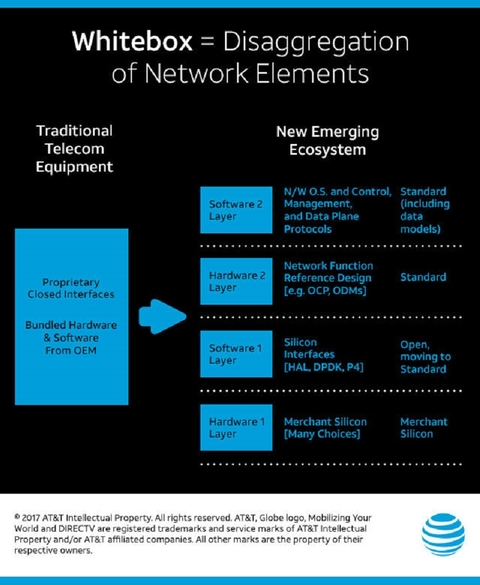AT&T may be motivated to migrate to a more open architecture based on software for its entire network, but the service provider is going to be careful about how it transitions the larger edge and core networks.
John Medamana, VP of packet optical network at AT&T, told FierceTelecom during the MEF17 show that the service provider will address various parts of its network in a staged manner.
“The packet network, which supports our internet, MPLS and Ethernet services, is bigger and more complex,” Medamana said. “What we said was let’s not go and attack it all at once, but let’s ask ourselves which areas it’s relatively easy to aggregate?”
RELATED: AT&T raises SDN network transformation goal to 55% for 2017
The service provider, which now uses a so-called white box CPE solution for its FlexWare service and disaggregated ROADM platforms for its optical network, is clearly on that track.
FlexWare allows businesses to set up multiple virtual network functions (VNFs), such as a router and a firewall, on a single FlexWare device and deploy them in different countries.
The service provider’s Flexware product set continues to resonate with customers. To date, the service is available in over 200 countries on Ethernet and TDM-based technologies supplied by either AT&T or one of its network access partners. FlexWare has been deployed in 30 countries.
“We created FlexWare, and the key technology that enables FlexWare is the Universal CPE (UCPE),” Medamana said. “The idea is there’s this customer disaggregated platform and the hardware is a whitebox with X.86 merchant silicon.”
Disaggregation challenges
For AT&T, the initial drive of migrating to more open network platforms was to disaggregate long-running combination of hardware and software network platforms.
This a change from the closed proprietary way vendors sold their platforms for the past century. In this configuration, a service provider was relegated to the vendor’s upgrade and update cycles, making service introductions long and costly.
“The first layer of our process is let’s remove the coupling of software and hardware,” Mendamana said. “This means I can procure hardware and software separately, which is starting to happen already.”
AT&T will address this challenge in a two-part process: disaggregate hardware and software and disaggregate software itself.
Medamana said that the idea of disaggregating the software “is more in the concept stage with its key vendor partners.”
But the same idea of disaggregated hardware and software is much harder to do in the core and edge network is much more challenging.
“A CPE router is a single deployment with a small blast radius, but if something goes wrong the core of the network it could have a larger impact,” Medamana said. “We’re beginning to have a dialogue on how best to do that.”

Driving flexibility
Regardless of the challenges that come with disaggregating hardware and software across parts of the network, AT&T says the ultimate benefit is more flexibility.
Service providers like AT&T will have more ability to immediately implement services.
This will be applied across AT&T and other service providers’ core IP and optical networks.
“When we’re done with this what it means is in our packet and optical networks is all of our network infrastructure will be white box hardware and disaggregated software,” Mendamana said. “We can plug in applications and integrate applications and we don’t have to rely on a single vendor.”
Still, Mendamana says the process is not going to happen overnight.
“It’s going to happen slowly,” Mendamana said. “There’s this phenomena that when put in infrastructure, it’s hard to rip that out.”